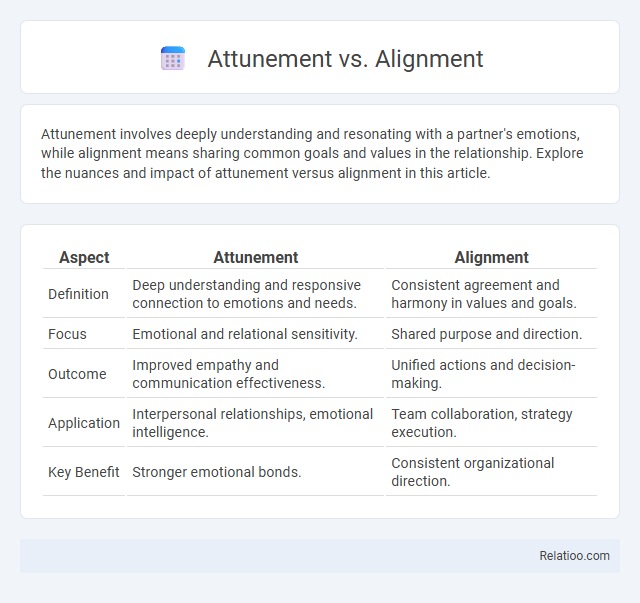Attunement involves deeply understanding and resonating with a partner's emotions, while alignment means sharing common goals and values in the relationship. Explore the nuances and impact of attunement versus alignment in this article.
Table of Comparison
| Aspect | Attunement | Alignment |
|---|---|---|
| Definition | Deep understanding and responsive connection to emotions and needs. | Consistent agreement and harmony in values and goals. |
| Focus | Emotional and relational sensitivity. | Shared purpose and direction. |
| Outcome | Improved empathy and communication effectiveness. | Unified actions and decision-making. |
| Application | Interpersonal relationships, emotional intelligence. | Team collaboration, strategy execution. |
| Key Benefit | Stronger emotional bonds. | Consistent organizational direction. |
Understanding Attunement and Alignment
Understanding attunement involves tuning oneself to internal or external frequencies, enhancing sensitivity and responsiveness to subtle energies or environments. Alignment refers to harmonizing beliefs, actions, and goals with core values or universal principles, promoting coherence and balance in personal or organizational contexts. Both attunement and alignment support optimal functioning but differ as attunement emphasizes receptive tuning while alignment centers on intentional consistency and integration.
Core Definitions: Attunement vs Alignment
Attunement refers to the process of becoming receptive and sensitive to specific energies, objects, or concepts, enabling a deep, intuitive connection. Alignment involves harmonizing one's actions, values, or energies with an external or internal standard, ensuring consistency and balance. Understanding the core definitions of attunement versus alignment helps you develop a clearer approach to spiritual or personal growth practices.
Origins and Theoretical Background
Attunement, alignment, and resonance originate from distinct theoretical backgrounds within psychology and spiritual traditions, each emphasizing different aspects of human experience. Attunement is rooted in attachment theory and developmental psychology, highlighting emotional synchrony and empathetic connection between individuals. Alignment derives from systems theory and organizational psychology, focusing on coherence between individual values and external structures, while resonance emerges from phenomenology and social theory, underscoring dynamic interpersonal understanding and embodied shared experience.
Key Differences in Application
Attunement involves fine-tuning one's sensitivity to subtle energies or environments for enhanced responsiveness, while alignment emphasizes harmonizing internal values and goals with external actions to achieve consistency and integrity. In practical application, attunement enhances moment-to-moment awareness and adaptability, particularly in interpersonal or spiritual contexts, whereas alignment guides long-term strategic decision-making and behavioral coherence. Understanding these distinctions enables tailored approaches in personal development, leadership, and therapeutic practices, maximizing effectiveness based on situational demands.
Benefits of Attunement in Relationships
Attunement enhances relationship quality by fostering deep emotional understanding and responsiveness between partners, leading to increased trust and intimacy. It promotes synchronized communication, enabling individuals to better recognize and respond to each other's needs, which reduces conflicts and strengthens emotional bonds. This heightened sensitivity in attunement cultivates empathy and support, creating a resilient foundation essential for long-term relational satisfaction.
Alignment in Organizational Success
Alignment in organizational success ensures that all departments, teams, and individuals share a common vision and strategic goals, enhancing overall efficiency and cohesion. It drives collective focus, improves communication channels, and fosters a culture where resources are optimized toward achieving key performance indicators. Unlike attunement, which emphasizes emotional and interpersonal awareness, alignment centers on synchronizing operations and objectives to produce measurable business outcomes.
Attunement vs Alignment: When to Use Each
Attunement involves harmonizing your energy with a specific object or environment, enhancing your sensitivity and connection, while alignment focuses on ensuring your actions and goals consistently match your core values and purpose. You should use attunement when seeking deeper awareness or connection to subtle energies, and alignment when striving for clarity and coherence in decision-making or life direction. Understanding the distinct applications of attunement versus alignment helps optimize your personal growth and effectiveness.
Practical Strategies for Achieving Attunement
Achieving attunement involves actively listening and responding to another person's emotional state with empathy and presence, which differs from alignment that emphasizes shared goals and values across teams. Practical strategies for attunement include mindful observation of nonverbal cues, reflective feedback to ensure understanding, and creating a safe space for open emotional expression. These techniques foster genuine connection and improve interpersonal dynamics by tuning into subtle emotional signals rather than merely coordinating actions or beliefs.
Best Practices for Building Alignment
Effective alignment requires clear communication of shared goals and consistent reinforcement of organizational values to ensure all team members are synchronized. Using frameworks like OKRs (Objectives and Key Results) helps establish measurable targets that drive alignment across departments. Facilitating regular feedback loops and collaborative decision-making promotes attunement, enabling teams to adapt dynamically while maintaining alignment with strategic priorities.
Integrating Attunement and Alignment for Growth
Integrating attunement and alignment enhances personal growth by fostering deep self-awareness and congruence with core values. Attunement involves tuning into internal and external cues, while alignment ensures actions reflect authentic intentions and goals. Their synergy cultivates holistic development, empowering individuals to navigate challenges with clarity and purpose.

Infographic: Attunement vs Alignment
 relatioo.com
relatioo.com